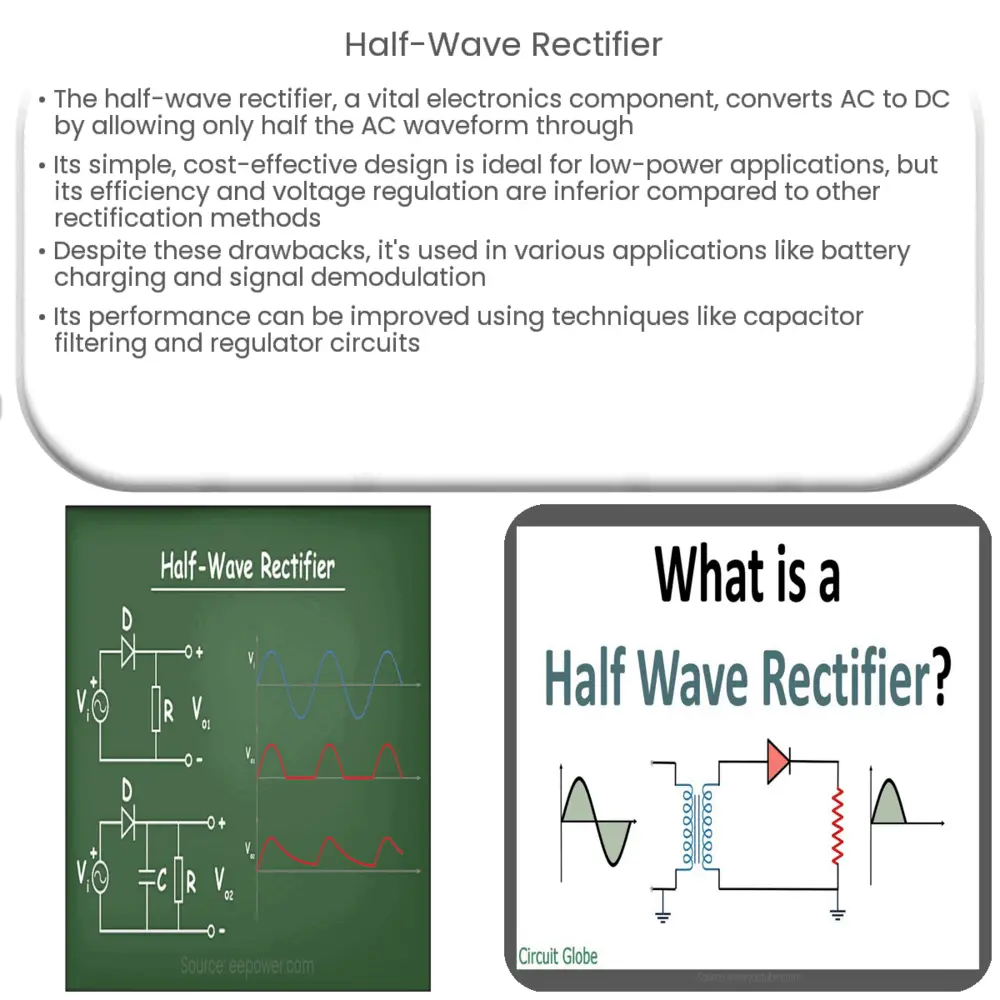A half-wave rectifier is an electronic component that converts AC voltage to pulsating DC voltage, utilizing a single diode in its simple design.

Half-Wave Rectifier: An Introduction
Overview
A half-wave rectifier is an essential component in the field of electronics, specifically in power supply circuits. Its primary function is to convert alternating current (AC) to direct current (DC) by allowing only one half of the AC waveform to pass through while blocking the other half. This article provides an in-depth understanding of the half-wave rectifier, its working principle, advantages, disadvantages, and applications.
Working Principle
At the heart of a half-wave rectifier is a semiconductor diode, which is a device that allows current to flow in only one direction. When an AC voltage is applied to a diode, it allows the positive half-cycle of the waveform to pass through, while blocking the negative half-cycle. As a result, the output voltage consists of only the positive half-cycles of the input AC voltage, effectively converting it into a pulsating DC voltage.
The basic operation of a half-wave rectifier can be summarized in two steps:
- During the positive half-cycle of the input AC voltage, the diode is forward-biased, allowing current to flow through it and producing a positive voltage across the load.
- During the negative half-cycle of the input AC voltage, the diode is reverse-biased, blocking current flow and resulting in a zero voltage across the load.
Advantages
- Simple Design: The half-wave rectifier has a straightforward design, requiring only a single diode to function. This simplicity makes it easy to understand, implement, and troubleshoot.
- Low Cost: Due to its minimal component requirement, the half-wave rectifier is an inexpensive solution for low-power applications where cost is a critical factor.
- Compact Size: The small size of a half-wave rectifier is another advantage, making it suitable for space-constrained applications.
Disadvantages
- Low Efficiency: As only half of the input AC waveform is utilized, the half-wave rectifier’s efficiency is relatively low compared to other rectification methods, such as full-wave rectifiers.
- Poor Voltage Regulation: Due to its pulsating nature, the output voltage of a half-wave rectifier exhibits significant fluctuations. This can lead to unstable voltage regulation, potentially impacting the performance of connected devices.
- High Ripple Factor: The half-wave rectifier has a high ripple factor, meaning that the AC component present in the output voltage is relatively large. This can result in increased noise and require additional filtering to produce a stable DC output.
Applications
Despite its drawbacks, the half-wave rectifier finds usage in various applications, particularly in low-power scenarios where simplicity and cost-effectiveness are prioritized. Some common applications include:
- Battery Charging: Half-wave rectifiers are used in basic battery chargers, providing a pulsating DC voltage to charge the battery.
- Signal Demodulation: In AM radio receivers, half-wave rectifiers are employed to demodulate the amplitude-modulated signal, extracting the original audio waveform.
- Power Supplies: Simple power supplies for low-power electronic devices may utilize half-wave rectifiers to convert AC mains voltage to a pulsating DC voltage.
- Welding Equipment: Some arc welding equipment incorporates half-wave rectifiers for controlling the welding current and voltage.
Improving Half-Wave Rectifier Performance
Although the basic half-wave rectifier design has inherent limitations, several techniques can be employed to enhance its performance. Some of these methods include:
- Capacitor Filtering: By adding a capacitor in parallel with the load, the voltage fluctuations in the output can be reduced, resulting in a smoother DC voltage with a lower ripple factor.
- Inductor Filtering: Inductors can also be used to filter the output voltage, attenuating the AC ripple component and further stabilizing the DC output.
- Regulator Circuits: Voltage regulator circuits, such as Zener diode-based regulators or integrated voltage regulators, can be incorporated in the rectifier output stage to maintain a constant and stable output voltage, regardless of input voltage variations or load changes.
Conclusion
In summary, the half-wave rectifier is a fundamental component in electronics, responsible for converting AC voltage to a pulsating DC voltage. While its efficiency and voltage regulation may be inferior to other rectification methods, the half-wave rectifier remains a popular choice for various low-power applications due to its simplicity, low cost, and compact design. By employing filtering techniques and voltage regulation circuits, the performance of a half-wave rectifier can be significantly improved, making it a versatile solution in the field of electronics.

